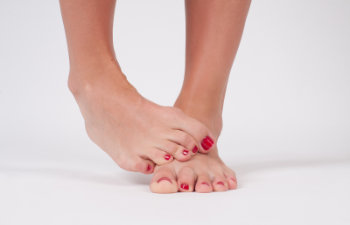
At Kayal Dermatology & Skin Cancer Specialists in Marietta, GA, we often see patients whose foot health and appearance have been affected by stubborn fungal infections. With summer approaching, many people look forward to wearing sandals and enjoying outdoor activities, making it even more important to address foot issues that can cause both discomfort and embarrassment.
Common Fungal Infections of the Feet
Two of the most common fungal infections affecting the feet are athlete’s foot (tinea pedis) and fungal nail infections (onychomycosis).
- Athlete’s Foot: A highly contagious infection that thrives in warm, damp environments like locker rooms and public pools. It can cause itching, redness, and cracking between the toes.
- Fungal Nail Infections: A slow-growing infection that causes nails to thicken, discolor, and sometimes crumble, often making the nails look unsightly and feel uncomfortable.
According to the American Podiatric Medical Association, fungal nail infections affect about 10% of the general population, with rates climbing to 20% in people over 60. Athlete’s foot is also extremely common, affecting approximately 15-25% of the population at any given time.
Causes and Risk Factors
Fungal infections are caused by dermatophytes, yeasts, or molds that invade the skin or nail tissue. Several factors can increase your risk of developing a fungal infection:
- Walking barefoot in communal areas such as gyms, pools, and locker rooms
- Having sweaty feet or wearing tight, non-breathable shoes
- Experiencing minor skin or nail injuries
- Having diabetes, circulatory issues, or a weakened immune system
- Wearing the same pair of shoes every day without allowing them to dry out
- Family history of fungal foot infections
Even small cracks in the skin or around the nails can allow fungi to take hold, making prevention and prompt treatment essential for maintaining healthy feet.
Symptoms to Watch For
Recognizing the signs of a fungal infection early can help prevent it from spreading. Symptoms of athlete’s foot include:
- Red, itchy, or scaly skin between the toes
- Burning, stinging sensations
- Blistering or peeling skin, sometimes accompanied by a foul odor
Symptoms of fungal nail infections often include:
- Thickened, brittle, or crumbly nails
- Yellow, white, or brown discoloration
- Nails that separate from the nail bed
- Distorted nail shape
- Unpleasant odor from the affected nail
If left untreated, these infections can worsen and even lead to secondary bacterial infections.
Effective Dermatology Treatments
At Kayal Dermatology, we offer advanced treatments to help eliminate fungal infections and restore your foot health just in time for sandal season. Our treatment options include:
- Topical antifungal creams, sprays, or lacquers for mild to moderate infections
- Oral antifungal medications for more persistent or severe cases
- Laser therapy to target and destroy fungal cells without damaging surrounding tissues
- Prescription-strength treatments customized to your needs
Our experienced dermatologists also provide education on best practices for foot hygiene, such as keeping feet dry and changing socks frequently, to help prevent recurrence.
Step Into Summer with Confidence
Fungal infections can impact both the appearance and comfort of your feet, but with the right dermatologic care, you can reclaim your healthy skin and nails. Don’t let fungal infections keep you from enjoying your favorite summer activities.
Contact Kayal Dermatology & Skin Cancer Specialists in Marietta, GA, today to schedule an appointment. With expert diagnosis and personalized treatment, you can step into summer with healthier, more beautiful feet!
Posted on behalf of
141 Lacy Street, Suite 200
Marietta, GA 30060
Phone: (770) 426-7177
FAX: (770) 499-0227
Email: kayaldermatology@gmail.com



